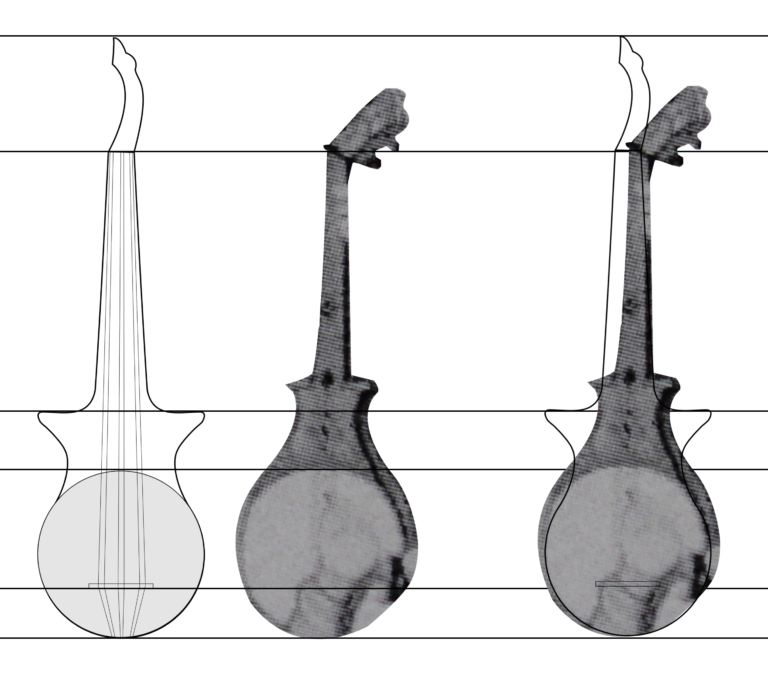
Image: Representation of the drawing presented in the Kanz al-Tuhaf dar musiqi
The Persian rubāb, or rubāb of the Kanz al-Tuhaf dar musiqi
The Kanz al-Tuhaf dar musiqi is a manuscript written by Hasan Kāshāni between 1355 and 1363. It is the first to present and describe a (Persian) rubāb, alongside other musical instruments. The original manuscript disappeared shortly after 1665, but no fewer than five copies have survived. The copies are divided into three sections: the first deals with the theory of music and Islam, the second with musical instruments, and the last section deals with philosophy and the influence of music on people.
The document on which I based the reconstruction of this ‘Persian’ rubāb is based on the work of the Japanese ethnomusicologist Tsuge Gen'ichi. This specialist focused on the second section, dealing with musical instruments. He carried out a comparative analysis of the information in this section proposed in the five copies.
Tsuge Gen’ichi, « Musical instruments described in a fourteenth-century Persian treatise Kanz al-Tuhaf dar musiqi » in Galpin Society Journal, n°66, Lance Whitehead, March 2013, p. 170.

Image: Representation of the reconstruction of the Persian rubāb from the description presented in the Kanz al-Tuhaf dar musiqi
Tsuge Gen'ichi reports the dimensions of the Persian rubāb mentioned in the Kanz al-Tuhaf dar musiqi : the ‘robāb [rubāb] has two cavities (baṭn), of two depths ('omq): the depth of the resonance box (kāsa) and the one at the beginning of the handle (gardan-e kāsa). The depth of each cavity is 7 angošt monżamm [145 mm]. The length of the cavity that forms part of the handle is 1 bedast and 4 angošt monfaraj [332 mm]. The width of each cavity is 1 bedast and 2 angošt monfaraj [290 mm]. The length of the handle (daste) is 3 bedast [748 mm]’. It was from these figures that it was possible to reconstruct the Persian rubāb. Only the dimension, indicated by the letter ‘X’ on the plan, is not mentioned, which will only slightly change the appearance of the instrument.

Image: Comparative representation of the Persian rubāb of a rubāb (also Persian) from a Mughal miniature
Comparing the Persian rubāb from the Kanz al-Tuhaf dar musiqi with a rubāb from a Mughal miniature, there are strong morphological similarities. Both instruments were resized with the distance from the saddle to the bottom of the resonator as a common measure. The diameter of the lower chamber of the two instruments is identical, with only the length of the ‘horns’ and the height of the middle chamber differing. It should be remembered that the height of the middle chamber is not mentioned in the manuscript (it is represented by the letter ‘X’ on the plan). These similarities imply that these two instruments, separated by two centuries, could have a common parentage. It is even possible to argue that the rubāb presented in the Kanz al-Tuhaf dar musiqi would be the ancestor of the Persian rubāb in Mughal miniatures. Unfortunately, there is no information about the appearance of the instrument's back, no Persian rubāb has come down to us and no rubāb in existence today is related to it.